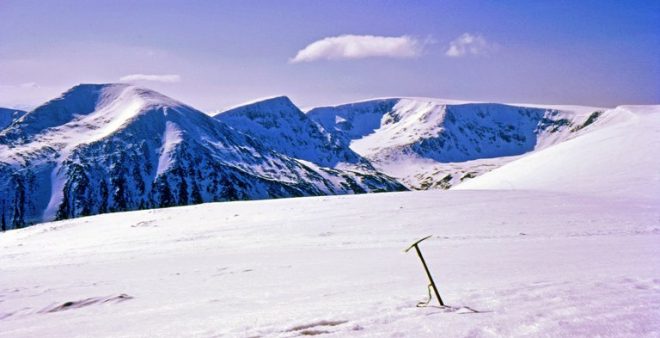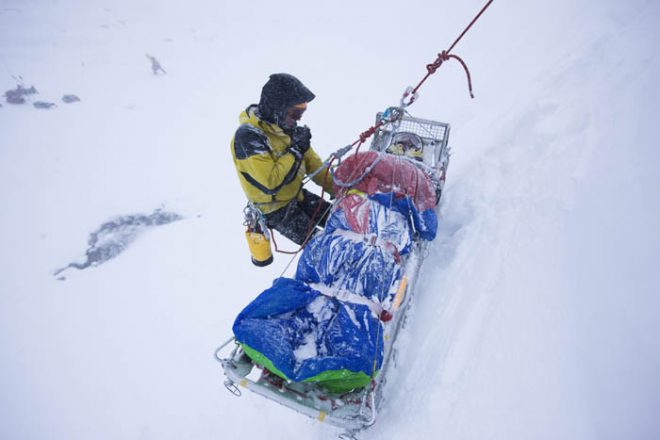
You’ve been enjoying a day’s walking in the mountains but now with darkness closing in you find yourself separated from your group and your lost. How reassuring then to know that a team of experienced mountaineers are on their way to search for you and take you safely off the mountain.
What’s On caught up with two such heroes, Iain Cornfoot of Cairngorm Mountain Rescue and Julian Fennema of Braemar Mountain Rescue Team to find out more about this vital emergency service.

The Cairngorm Mountain Rescue Team (CMRT) led by Willie Anderson has 43 team members. Seen here leaving their Inverdruie HQ and on exercise in The Cairngorms at Cnap Coire Na Spreidh practising rescue techniques. The Cairngorms, Scotland UK 27th January 2013
© COPYRIGHT PHOTO BY MURDO MACLEOD
So, how long have you been a part of Mountain Rescue and what attracted you in the first place?
Iain: I have been a member of the Cairngorm Mountain Rescue Team since 1995. I joined a training program at the age of 15 and moved into the full team at the age of 18. The chance to learn climbing and mountaineering skills from respected guys in the team first attracted me to CMRT.
Julian: I was fortunate to have the chance to climb and hillwalk as a youth, spending several summers in the Alps before concentrating on a career as an academic. On moving to Braemar I decide to find out if I could make a more direct contribution and was thrilled to be given the opportunity – I joined the team as a trainee in October 2015 and was accepted as an operational member the following July.
How many members are in your team and what are their backgrounds?
Iain: CMRT has 42 members who are all volunteers, from all different walks of life: Mountain Guides, Doctors, Builders, Ski Patrollers, and Teachers to name a few! The one thing that we all have in common is a love of the mountains.
Julian: The BMRT benefits from a close collaboration with Police Scotland, and approximately a quarter of our 38 members are serving officers. The rest of us are a motley crew of teachers, estate workers, engineers, tour guides… all walks of life are represented.

So what do you need to volunteer & become part of the team?
Iain: You need to have lots of time to attend training and the ability to be flexible and leave other commitments if there is a call-out. A sense of humour is also a good thing!
Julian: The willingness and ability to be part of a team operating in challenging environments and circumstances is certainly up there, along with hill skills. That said, the most important element is the support (and forgiveness) of partners and family; meals are left uneaten, conversations unfinished and chores incomplete because when the phone goes off it’s time to go!
Why do people get into difficulty?
Iain: People can get into difficulty for a number of reasons, anything from a fall when climbing to being caught out by the ever-changing weather.
Julian: The public discourse tends to concentrate on poor preparation or risk evaluation, but there is a myriad of reasons. The team operates without judgement – somebody is out there having one of the worst days of their lives and we are trained, equipped and supported to help them.

The Cairngorm Mountain Rescue Team (CMRT) led by Willie Anderson has 43 team members. Seen here leaving their Inverdruie HQ and on exercise in The Cairngorms at Cnap Coire Na Spreidh practising rescue techniques.
© COPYRIGHT PHOTO BY MURDO MACLEOD
So what happens when you receive a call?
Julian: A rescue callout will be coordinated by one of our specially trained team members who will plan and implement an appropriate response. When the phone goes we need to move as fast as we can to get suited and booted, fill the thermos, grab the rucksack and get to the rescue centre. In October it was 8 minutes from receiving a call (about to get into the shower after a trail run) to being aloft in a helicopter.
How do you reach high, inhospitable terrain?
Iain: We have various ways that we can reach the high areas of the Cairngorms. If the weather is favourable, we would mostly try to ask for assistance from the Search and Rescue (SAR) helicopter. If this isn’t an option we use Land Rovers, ATVs, Piste Grooming Machines from the Ski Area but most of the time it will just be on foot.
Training must be intensive?
Iain: Yeah, there are lots of different facets to Mountain Rescue that we train for but the training officers always ensure a variety. Our most intensive training period is pre-winter when we recap a lot of the avalanche and medical protocols. A lot of the senior team members will help at the training events; it’s always pretty varied and good fun!
Julian: A training day is an intense learning experience, focused on skills that will keep us safe and those who we go out to rescue. The advantage of living in the Braemar area, though, is that we are all out in the outdoors regularly, be it alone or practicing with other team members, thereby supplementing the formal training.

How is the service funded?
Iain: The Cairngorm team receives funding from the government as part of a grant for all Mountain Rescue teams in Scotland. This equates to about 20% of our running costs with a further 10% coming from Police Scotland. One of the main differences between us, and a lot of other teams in Scotland is that we are independent from Scottish Mountain Rescue (SMR). As a result, if anyone donated to SMR, the Cairngorm team would not receive any percentage of these donations. The other 70% of our running costs is made up of donations directly to the team as well as fundraising.
Julian: The balance for each team is different, as is the end cost. For Braemar MRT approximately a quarter is received from government through Scottish Mountain Rescue, but the rest is the generosity of the public. Fundraising forms an important part of team activity, and we benefit from donations at events as well as bequests. These are often linked to amazing personal stories, sometimes tragic ones, and serve to remind us why we do what we do.
With winter approaching what words of advice would you give to those heading for the hills?
Iain: Start early. Always give yourself enough time for unforeseeable changes in conditions or weather. Have the mindset to change your plans should the weather and snow conditions not be favourable.
Julian: Dealing with winter conditions is not just about lots of shiny new gear, but also the experience to make good decisions and knowledge of how to use the equipment. If in doubt, there are some great training courses out there. Regardless, though, always remember to let someone know where you are going and when you’ll check back in – this is vital information for the rescue teams.
To learn more about CMRT & BMRT or to donate to these remarkable organisations, visit www.cmrt.org.uk and www.braemarmountainrescue.org.uk
Join our Mailing List
Sign up to get notified of the latest deals, news and all the latest information direct to your inbox.
